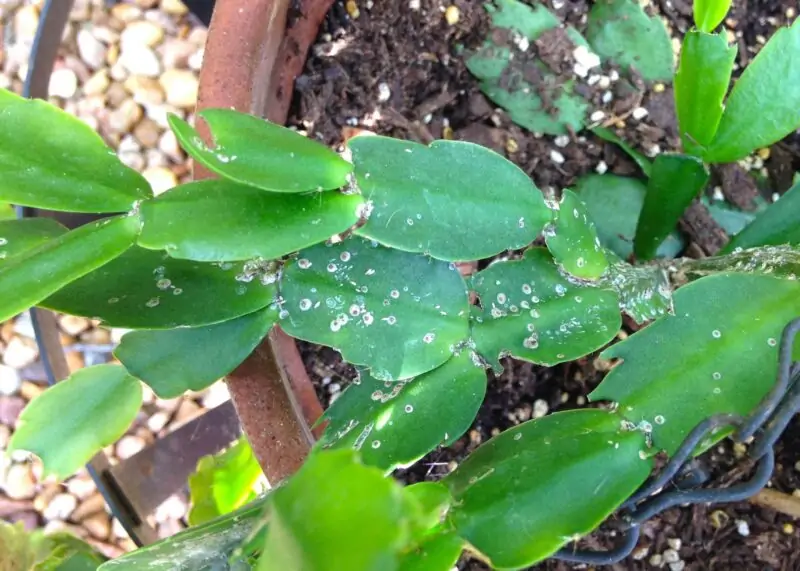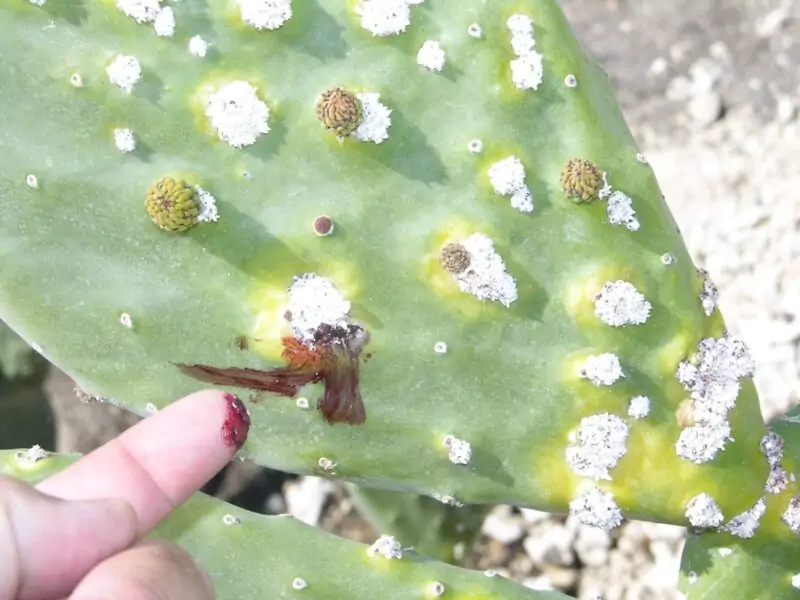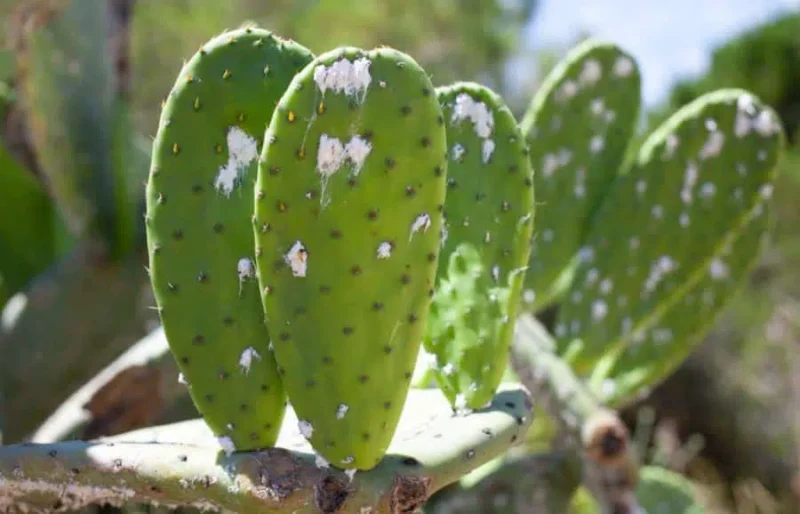White Spots on Cactus: How to Get Rid of Mealybugs

Are there white spots on your cactus? Don’t worry, there are many ways to deal with this common issue. Cactus plants are popular among plant lovers because they are interesting and come in various shapes and sizes. However, they require special care to grow well and stay free of problems like white spots caused by pests or diseases.
This article will tell you everything you need to know about taking care of your cactus plants and getting rid of white spots caused by pests or fungus. We’ll also tell you how to prevent these issues in the future.
Why Are There White Spots on Cacti?
White spots on a cactus can appear as fuzzy patches or web-like structures covering parts of the plant’s surface. These can be caused by different factors, such as a fungal infection from overwatering or an insect population, like mealybugs, which feed on the sap in the plant’s tissues and cause a discoloration called chlorosis. These annoying pests can even infest succulents you grow in pots in your indoor garden.
Any sign of poor health in a living thing, including our beloved houseplants, should never be ignored. Addressing these early warning signs is crucial not only for aesthetic reasons but also for the plant’s health. If left untreated, these issues could lead to more damage or even death.
Cactus Care
To maintain a healthy-looking cactus, remember that in their natural habitat, they thrive in hot and dry conditions. It is essential to water them regularly, provide the right soil mixture (preferably gritty), and direct sunlight while avoiding excessive nutrient-rich fertilizers.
Cacti are favored by plant enthusiasts because they are easy to care for and provide visual interest all year long. When placed strategically around a room, they can bring life to dull corners that would otherwise be left empty.
Cactus Turning White: Mealybug Infestation

Most of the time, white spots on a cactus are caused by pests like mealybugs. They feed on the sap in plant tissues, causing chlorosis, which shows up as green or bleaching of the plant tissue. Spider mites and scale insects like cochineal bugs can also cause similar problems when they feed on plants.
Pests such as mealybugs and scales eat through the plant’s top layer to access the sap. They leave behind a sticky substance called honeydew, which ants love but is detrimental to the plant’s health.
The life cycle of these pests is quite interesting! Adult pests lay their eggs in cracks or under leaves. When the eggs hatch, the young nymphs crawl around until they find a suitable spot to settle and grow into adults.
Fungus Growth on Your Cactus Plant
Fungi thrive in warm, damp environments with little airflow. This makes it easy for fungal spores to spread across surfaces, causing discoloration like powdery mildew patches on stems and leaves.
Overwatering your cactus can lead to fungal infections, as moist soil is an ideal environment for fungi to grow. This can cause further damage if left untreated.
Fungal infections weaken the entire plant, leading to stunted growth, twisted leaves, and ultimately death.
Identifying White Spots on Cactus
Differentiating Between Pests and Fungus
By scraping the white spots with your nails, you can determine if pests or fungus are affecting your plant. If the spots feel sticky, it’s likely a pest issue, but if the spots come off easily, it’s probably a fungal problem.
Identifying the cause of the white patches is essential for selecting an effective treatment without causing additional harm to your plant.
Recognizing Pest Infestations
Pest infestations can cause white spots on your cactus, and it’s crucial to identify these early to treat them effectively. Mealybugs, scales, and spider mites are common pests that attack cacti. Here’s how to recognize pest infestations on your cactus:
- Visible cottony-white spots: These can be found on the roots, stems, and leaves of the cactus. The presence of these spots indicates that pests are feeding on your plant.
- Sticky residue: Pests like mealybugs and scales feed on the plant’s sap and leave behind a sticky substance called honeydew. This sticky residue can attract ants and other insects, making the problem even worse.
- Stunted growth: Infestations can cause your cactus to have stunted growth, which can eventually lead to the plant’s death if not treated.
- Deformed leaves: Pests can cause leaves to become twisted, discolored, or misshapen.
- Presence of pests: Look closely at your cactus to see if you can spot any pests such as mealybugs, scales, or spider mites. Use a magnifying glass if necessary to get a closer look.
Once you have identified a pest infestation on your cactus, it’s essential to take immediate action to eliminate the problem and prevent further damage to your plant. Treatments include using rubbing alcohol, insecticidal soap, or neem oil. You can also introduce beneficial insects like ladybugs or lacewings to your garden, as they feed on pests like mealybugs and scales.
By regularly inspecting your cactus and taking proper care of it, you can prevent pest infestations and fungal growth, ensuring a healthy and beautiful plant for years to come.

Ways to Get Rid of Mealybugs on Your Cactus
Rubbing Alcohol Method
How to Kill Pests with Rubbing Alcohol, Step-by-Step:
- In a spray bottle, mix 1 part rubbing alcohol with 9 parts water.
- Spray the affected areas straight until they are completely soaked.
- Leave for a few hours to give the solution time to work and kill any mealybugs or scales that are still there.
What to watch out for when using this method
Wear gloves when handling rubbing alcohol because it can irritate the skin if it comes in direct touch. Also, don’t spray plants when the sun is right on them!
How to Make and Use Homemade Insecticide
The ingredients and steps
- Two tablespoons of neem oil should be mixed with a gallon of water.
- Add one tablespoon of liquid soap
- Spray the affected areas straight until they are completely soaked.
How to Put the Insecticide on Cacti
Apply the solution evenly to all surfaces, including stems and leaves, with a spray bottle. Stay out of direct sunshine.
Bugs That Do Good
Different kinds of helpful bugs that can be used to get rid of pests. Ladybugs are great hunters that eat mealybugs and scales, and lacewings help control the number of pests by eating their eggs.
How to get bugs that are good for your plants into your garden
When bringing in helpful insects, you need to plan carefully because they could hurt other bugs or even your plants. Before moving forward, it’s best to talk to an expert.
How to Stop White Fuzz Caused by Fungi
Cut off the infected parts and spray them with fungicide.
How to cut off infected parts of cacti and what to do with them
- Cut off any infected parts with sterilized gardening tools, leaving only healthy parts.
- Put infected parts in bags that can’t be opened so that the germs don’t spread and do more damage than they need to.
How to use pesticide spray on the parts that are still healthy
Fungus attacks need to be treated quickly, or they will spread to the whole plant and kill it. Use the right fungicides and apply them according to the directions to get the effects you want.
Homemade Fungicide Recipe and Application
How to Make a Homemade Fungicide: List of Ingredients and Steps
- If you mix one part baking soda with three parts water, you can make your own fungus killer. Adding a few drops of dish soap is unnecessary.
- Spread this mixture over the whole surface of the cactus until it is completely covered.
How Should It Be Applied to the Affected Areas?
Pour it slowly from the top down so you don’t miss any spots. Don’t spray it in full sunlight because it will dry too quickly.
How to Protect Your Succulent from Pests and Fungi
Best ways to take care of your plants
To grow well, cacti need specific care: don’t overwater them, give them the right kind of dirt and direct sunlight, and don’t pack too many plants together.
Strategies to lower the risk of pest infestations and fungal growth
Experts say that inspecting and cleaning plants regularly, giving them the right amount of water, and fertilizing them with nutrient-rich recipes could help reduce the risk of pest infestation or fungal growth.
White Stuff on Your Cacti: an FAQ
Overview of the different ways to treat white spots on cacti, including sprays that kill insects and fungi, rubbing alcohol, and beneficial bugs. Before going any further, choose the treatment method that fits your plant’s health the best.
A simple test is given to tell the difference between the two causes. A quick diagnosis is needed before any treatments can be done.
Some things that can make cactus turn white are too much direct sunlight or very cold temperatures. Don’t do these things when taking care of your plants.
If you don’t fix the damage right away, it will cause long-term problems like reduced growth and twisted leaves, which will eventually kill the plant.
The risks of overcrowding and bad care could be reduced by giving the plants enough water and food and checking on them and cleaning them regularly.
Conclusion
Pests like mealybugs and scales can cause white spots on your cactus by feeding on the plant’s sap which in turn leads to chlorosis. Overwatering can also result in white spots due to fungal growth, which can ultimately kill the plant if left untreated. Before treating white spots, it’s crucial to identify the cause to avoid causing further damage or harm.
Proper cacti care involves providing the right amount of water and the appropriate type of soil, placing them in direct sunlight, and avoiding overcrowding. Regular inspection, cleaning, and fertilizing with nutrient-rich formulas can help reduce the likelihood of pest or fungal infestations. By implementing these strategies, you can keep your cacti healthy and thriving.